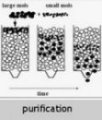As an X-ray crystallographer I undertook research to work out the physical structure of particular protein molecules, because this provides information about how they function. You might be asking yourself why do we need a picture of these molecules in order to find out how they work.
Imagine trying to describe to someone who’s never seen a car, how it drives you from one place to another, but you can’t show them any pictures. You could tell them it has 4 wheels, uses petrol and is mostly made of metal and glass, but it would still be very difficult for that person to understand without seeing any kind of diagram. You just don’t know what they might be imagining from your description…
 Knowledge of a protein’s structure is also useful when trying to design drugs or methods to specifically target them with the goal of preventing or treating a disease. Being able to ‘see’ what and where you are aiming at or trying to manipulate makes it easier to achieve this.
Knowledge of a protein’s structure is also useful when trying to design drugs or methods to specifically target them with the goal of preventing or treating a disease. Being able to ‘see’ what and where you are aiming at or trying to manipulate makes it easier to achieve this.
In reality my work consisted of protein expression (trying to persuade bacteria to act as little biological factories to make the protein I am interested in finding out about), purification (separating the protein I want from everything else), crystallisation (finding conditions in which the protein will crystallise like sugar granules), data collection (firing X-ray beams at it to get structural information) and model building (using a computer to translate the data into a picture of the protein’s structure).









